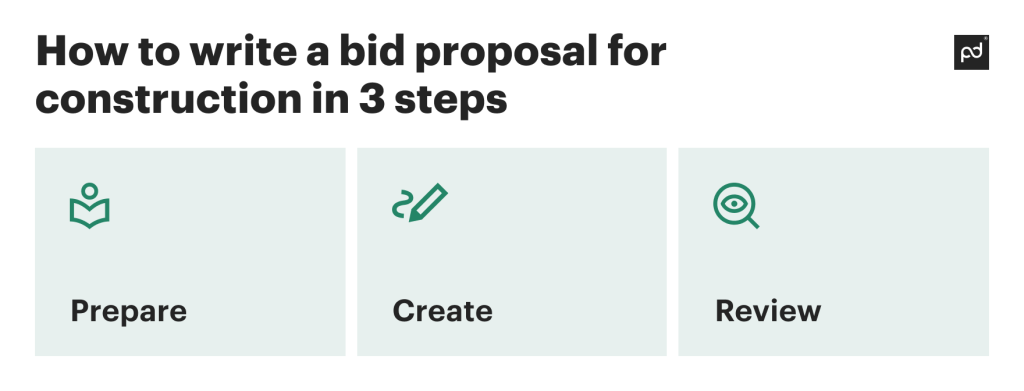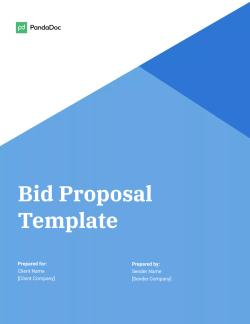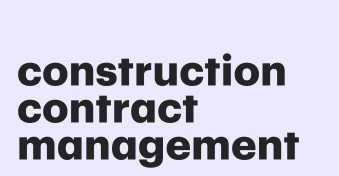Unsure how to write a proposal?
How about how to write a construction bid proposal that wins? We’re here to help.
In this guide, we’ll take you through everything you need to know about construction bid proposals, from what they are to how to write them, plus some handy tips for getting the most out of your construction bid proposal.
Key takeaways
- A construction bid proposal details how your company will tackle a given project
- Construction bid proposals are crucial to getting construction work
- A good construction bid proposal will be realistic, specific, and personalized to the client’s needs
- Proposal software can be a huge help when writing construction bid proposals
What is a bid proposal?
A construction bid proposal is a document provided by a contractor to a client or project lead.
It details the work that could be undertaken, the project scope, timeline estimates, cost estimates, etc.
Usually, construction bid proposals are provided to win the contract and be chosen to undertake the works.
But sometimes, a company may be asked for a proposal even after they have won the contract.
This is because a proposal document also serves as a good record of what both parties have offered and agreed upon.
What’s the difference between a construction proposal and a construction bid?
The terms ‘construction bid’ and ‘construction proposal’ are sometimes used interchangeably.
But there are essential differences between the two.
A construction proposal gives specific details of what the construction company will do for the project, how they will achieve it, the materials they will use, the time it will take, how much it will cost, and so on.
Construction proposals are tailored towards specific projects, and they aim to demonstrate the unique value the firm can offer to the client/project.
Construction proposals persuade clients and project leaders to award project contracts to your firm.
A construction bid, on the other hand, serves as a comparative tool.
It helps the client to compare different offerings and select whichever is most suitable for their aims.
Generally, a bid is less detailed than a proposal and more figures-based.
It doesn’t have to pitch as persuasively as a proposal because it’s a comparative tool rather than a persuasive one.
Construction bids and construction proposals are very similar, but it’s still a good idea to understand the differences between them.
Why are construction proposals important?
Construction proposals are essential for several reasons:
They provide clarity for all parties
When written well, a construction proposal will clearly define the contractor’s provision, including timeline and costs.
This clarifies and ensures that both contractor and client are on the same page as the project proceeds.
They give transparency
Clients and project leaders hate being hit with hidden costs by contractors.
A detailed proposal helps to prevent this.
While extra expenses are sometimes unavoidable as the project moves forward, a proposal adds a layer of transparency that inspires trust.
They help with planning
A well-written construction proposal can act as a blueprint for resource planning.
It can be referred to when setting schedules, ordering and allocating resources, and coordinating tasks.
They boost brand identity and reputation
Construction proposals are an excellent opportunity to reinforce your brand identity and stand out.
Using branded colors and styles on your construction bid template makes you look like a professional, trustworthy company that knows what it’s doing.
Over time, consistent branding in proposals will make your brand instantly recognizable and boost your brand reputation.
They help clients to make the right decision
The major purpose of construction proposals is to help clients and project leaders choose the right contractor for the job.
Good proposals are essential for encouraging clients to pick your firm.
What should a construction proposal include?
It’s helpful to have templates for construction proposals.
A good construction proposal template will include:
- Contact information for your firm. If a specific person handles this project/proposal, include their contact information.
- The parties that will be involved in the project
- The scope of the work
- Proposed work schedule
- Relevant authorities and responsibilities
- A breakdown of costs
- Relevant terms and conditions
- A warranty
- Signature lines for all relevant parties
How to write a bid proposal for construction in 3 steps

So, now you know what a bid proposal for construction is, why it’s essential, and what it should include. But how about how to write a construction proposal?
Let’s take a look:
1. Prepare your construction bid proposal
When preparing your construction bid proposal, doing as much research as possible is a good idea.
You must have a deep and accurate understanding of what is needed for the project and what you can provide.
It’s always tempting to offer more than you can give to make your proposal seem competitive.
But if you over-egg your proposal, you’ll only set yourself up for problems.
So, take a good look at what the project requires.
Think hard about how you would achieve what’s needed, the resources you could use, and the timescale in which you could realistically complete the work.
Think also about why the client should pick you over your competitors.
What unique benefits can you bring to the project that others can’t?
What makes you a better fit for this project than any other contractor?
Once you understand what the project requires and how you would approach it, it’s time to start creating your proposal.
2. Create your construction bid proposal
When creating your proposal, make sure to include all the elements we spoke about above.
If you’re unsure how to do this, here’s a quick run-through:
Contact information
Start with the contact information for your firm.
If you assign a particular person to this project, include their contact information.
Remember, you want to make it easy for the client to get in touch and offer you the contract. So, make your contact information clear and easy to see.
Parties involved
Clearly define the parties involved in this project.
Usually, this will be your firm and the client/project leader, but you may wish to involve subcontractors and other stakeholders.
The scope of the work
Detail the work you will perform as part of this contract.
Go through all the tasks and activities you must complete for the project. Be as clear and detailed in this section as you can.
If you plan to bring in subcontractors for any portion of the work, be sure to detail who they are and what they will be doing.
Proposed work schedule
Every contractor knows that projects rarely run according to a strict schedule.
But you should still try hard to provide a schedule that’s as accurate as possible.
Clients need a realistic idea of how long your work will take.
Provide proposed start and completion dates in this section.
And don’t forget to account for the time needed for things like getting permits and approvals.
It’s also good to give yourself some flexibility in your proposed schedule for things like bad weather and other unexpected delays.
Relevant authorities and responsibilities
This section is all about compliance.
Identify any regulatory authorities that are relevant to your project. For example, does the project need to comply with specific building codes?
If so, who is responsible for overseeing these codes?
Which authorities and regulators will you need to communicate with over this project, and who will be responsible for doing so?
Cost breakdown
This is often the first section any potential client will look at, so your cost breakdown must be competitive and realistic.
Construction estimating software can be a big help with this.
Break down all the costs you think you will encounter, including:
- Materials
- Labor
- Equipment
- Permits
This is also the section to include a payment schedule so the client knows what they would be expected to pay and when and how.
Terms and conditions
Imposing terms and conditions on your potential client may feel awkward, but it’s crucial to be as rigorous and specific as possible.
Clarifying terms and conditions from the outset will help things move more smoothly.
When setting down terms and conditions, think about:
- Payment terms
- Insurance
- How you will handle any disputes that arise
Warranty
This is where you detail any warranties or guarantees you plan to offer. Ensure you are specific about warranty/guarantee terms and conditions, durations, etc.
It’s also a good idea to specify anything that you won’t be held liable for, or that won’t be covered under your warranty.
Signature lines
This one is pretty self-explanatory. Make a space for all relevant parties to sign.
Signing indicates that they agree to your proposal and all terms and conditions outlined therein.
Once signed, you must also stick as closely to your proposal as possible.
3. Review your construction bid proposal
Once you’ve created your construction proposal or bid proposal, review it thoroughly.
You’d be surprised how many things you can miss while writing your proposal.
Read your proposal back through once it’s complete.
Get someone familiar with the industry to cast fresh eyes over it if possible. This can lead to valuable insights and advice.
Top tips for writing a construction bid proposal
Here are some tips to help you nail your construction bid proposals every time:
Personalize your proposals
Clients want to know that you have thought seriously about the specific needs of their specific project.
If your proposal sounds too generic or too boilerplatey, it won’t inspire faith that you’ve understood their particular needs.
So, personalize your proposal template for each new client and project.
Show that you understand the aims and objectives of each project, and use language that makes it clear you know both the client’s pain points and how to solve them.
Use professional design
A well-designed construction bid proposal template gives a great impression from the outset.
It shows that you care about your reputation and have the resources to do a great job at everything you put your hand to.
You can customize PandaDoc’s professional-looking templates with your brand colors and designs.
With PandaDoc’s templates and your branding, you can create proposals that stand out before the client has read a single word.
Be detailed and specific
Ambiguous language and vague statements don’t tell the client anything they need to know.
So, be as specific as you can.
Give solid examples, use verifiable data, and provide specific details of everything, from the materials you plan to use to the costs you will incur.
Focus on your impact
At all points, highlight the positive ways your company can impact the project.
Ideally, you can impact the project in ways that competitors cannot. Demonstrate this at every opportunity.
Be realistic
Don’t make promises you can’t keep. At all points, be as realistic as possible.
Put together an achievable timescale and cost breakdown.
Remember, while some deviation from your proposal is inevitable, your reputation will be damaged if your timescale, costs, and so on are too far away from what you promised.
Construction proposal template
You can get construction proposal templates from many Proposify competitors, such as PandaDoc.
Here is one example of PandaDoc’s useful construction proposal templates.
Remember, you can customize these templates for your brand.
Example of a bid proposal
As we mentioned earlier, a bid proposal and a construction proposal are slightly different.
If you’re looking for a template specifically for bid proposals, here’s an example.
Increase your close rate with online proposal software
With business proposal software from PandaDoc, you can increase your close rate by up to 18%.
Easily create, eSign, and send impressive proposals to your prospects.
Want to know more? Check out our business proposal software here.
Frequently asked questions
-
Avoid ambiguous or generic language when writing a construction bid proposal. Clients will want specifics and will discard any proposal that’s too vague.
You should also be realistic. While it’s important to be competitive with your proposal, don’t offer things you know you can’t provide.
-
A construction proposal should look professional. Ideally, you should customize your proposal templates with your branding to make your proposals look sophisticated and boost your company’s reputation.
-
Writing an independent contractor proposal is easy with the proper templates and software. It’s essential to research each project before you write your proposal correctly and to make sure that you fully understand the client’s needs.
Once you have researched the project and devised a strategy for tackling it, use that strategy to fill in your construction proposal template.
-
If you receive a request for proposal (RFP) and think that the project is something you could work on, write a proposal.
The requester may have their own proposal template for you to fill in. If not, PandaDoc has proposal templates and software that make writing construction bid proposals easy.
Disclaimer
PandaDoc is not a law firm, or a substitute for an attorney or law firm. This page is not intended to and does not provide legal advice. Should you have legal questions on the validity of e-signatures or digital signatures and the enforceability thereof, please consult with an attorney or law firm. Use of PandaDoc services are governed by our Terms of Use and Privacy Policy.



